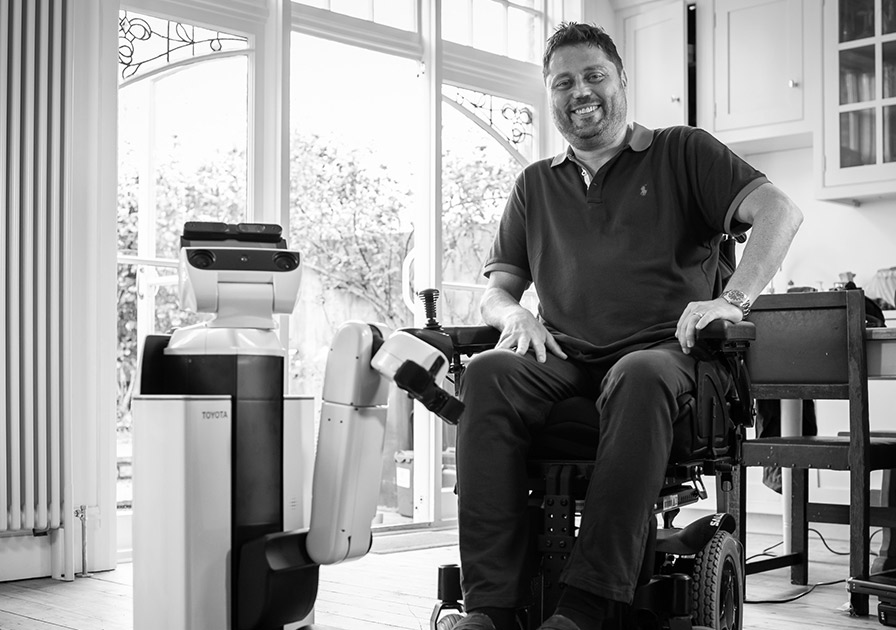29 November 2021 Care

It fetches objects, opens doors, waves, and even dances and sings – this is the prototype Toyota Human Support Robot (HSR). Anthony Walsh, who lived with motor neurone disease (MND) was the first person in the UK to welcome the machine, designed to help with everyday tasks, into his home. The HSR project was born through Toyota GB’s three-year charity partnership with the MND Association. The results of the home trial are revealed in a new short film.
Anthony lived in Southgate, North London, with his wife Siobhan and two young children. He was diagnosed with MND in May 2021 and within months went from playing football to relying on a wheelchair to move around.
“Not being able to walk for the last month has been very hard to cope with. I’ve lost my mobility and I have to be dependent on others, which is not the sort of person I was.”
Anthony
The HSR is a service robot that can help people at home. It is one of Toyota’s robotics concepts now under development as part of the company’s global mission to provide freedom of mobility for all. It can grab objects, interact with humans and navigate around different environments.
During the home trial, the HSR was manually controlled by an operator to perform everyday tasks for Anthony and his family, such as bringing a carton of orange juice from the fridge, and passing objects like the TV remote control and a box of tissues. It even sang using Anthony’s voice which had been ‘banked’ in advance. While the robot is currently manually controlled, King’s College intends to collaborate with Toyota and the MND Association to develop its functionality and its ability to act on pre-programmed commands.
“We’re just getting the first taste of what the future might hold and what technology is out there that might be manipulated to help people in my condition, particularly those who maybe don’t have the same support network as I do. I think there could be a place where this robot could be there to help people in different ways with their day-to-day life. It gives you back a little bit of your independence, albeit you’re still relying on something else. This robot would actually free up time for other people to not always be at your beck and call and to have some of their own time back. It can relieve a lot of stress in the family situation.”
Anthony
Anthony died soon after the robot home trial, and after discussions with his family the film is being released to respect his wish to raise awareness of MND and the work of the MND Association.
“The Toyota HSR robot is a brilliant example of how innovative technology could help to improve the lives of people living with MND, and why partnerships with pioneering companies like Toyota are vital to explore what might be possible in the future. We are incredibly grateful to Anthony and his family for being so open and enthusiastic about trialling the robot in their home and contributing to the development of this exciting technology. The sad news of Anthony’s death is a stark reminder of why we must continue our efforts towards a world free from MND. Until that day comes, we will continue to push boundaries of what may be possible in care and support for people living with MND today.”
Nick Goldup, Director of Care Improvement at the MND Association
“We’ve been offering the HSR open innovation platform to research partners worldwide, and although the robot isn’t on general sale to the public, this home trial with Anthony Walsh has provided hugely useful insights into how this type of robot could help people in the future. It is a perfect expression of how Toyota as a mobility company wants to make freedom of movement, and the opportunities that brings, available to everyone in society.”
Mark Van Loock, Technology Manager at Toyota Motor Europe (TME)

In memory of Anthony Walsh 1969 - 2021
This content is hosted by a third party
You must consent to targeting cookies set by the third party to view this content.
Manage cookie preferences